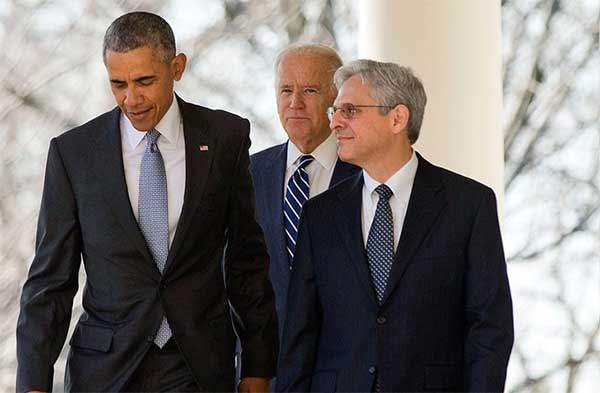By Dr. John Sparks


Grove City, PA -(AmmoLand.com)- With the death of Justice Antonin Scalia the Supreme Court is left with one chief justice and seven associate justices.
President Obama has nominated Merrick B. Garland, chief judge of the D.C. Circuit Court of Appeals, who was a Clinton appointee and clerked under liberal Supreme Court Justice William Brennan. Even before the nomination, the vacancy produced urgent calls for a replacement to be nominated based on claims that an eight-person court would not be “fully functioning,” would “hamstring the judiciary,” and would amount to “partisan understaffing.” With Obama’s nomination of Garland, the clamor for immediate action will increase.
But is an eight-person Supreme Court really unworkable for the period between now and early 2017 when a newly-elected president will offer a replacement?
First, some history. Article III of the Constitution says that judicial power shall be vested in one Supreme Court and such other inferior courts as Congress shall ordain. It always came as a surprise to my Constitutional students that the size of the Supreme Court is not set at nine by the Constitution. In fact, the first Court was six-members —the chief justice and five associate justices. Between then and 1869, the Court was sometimes seven, sometimes 10, and sometimes nine. But the Judiciary Act of 1869 finally fixed the number at nine—one chief and eight associates. It has not changed since, with the best-known attempt at increasing its size being FDR’s unsuccessful “court packing” scheme in 1937.
The immediate question is: Can the Supreme Court effectively operate with only eight judges? Yes, it can. Even with nine members, it does so when a justice recuses himself or herself because of an actual or potential conflict of interest, thus taking the number to eight. That has happened as recently as the Fisher v.University of Texas case where Justice Kagan did not participate because she had worked on one side of the case as solicitor general. In fact, in her first term beginning in 2010, she recused herself from 28 cases out of the 75 decided opinions. The court operated in over one third of its cases with just eight justices during that entire term.
However, what about those close and controversial 5-4 decisions of which Justice Scalia was a part? Isn’t it likely that the court will be essentially deadlocked on some important constitutional issues? Yes, that is a possibility but not as likely as one might think.
The court’s statistics here are enlightening. For the term for which we have the most recent data, the October 2014 term that ended June 2015, the Supreme Court issued 74 opinions on the merits of which only 19 were 5-4 opinions (26 percent). Of those, 13 can be said to have been generated by ideological splits between the conservative and the liberal wings of the court. Moreover, this particular term was reasonably contentious, containing the Obergefell case (same-sex unions), King v. Burwell (tax credits under Obamacare), and Michigan v. EPA (costs to businesses of regulation). Taking a look back over the decade of the Chief Justice John Roberts’ court, a similar pattern emerges. For the 10 years starting in the 2005 term, the percentage of total opinions that were 5-4 averaged 22 percent or 17 decisions. The point is that much of what the court decides is not dependent upon nine justices. Because most of the decisions are not close, eight justices will do the job.
Nevertheless, what about a Supreme Court term in which there were a number of ties? What happens to those cases? If a case is argued and decided but the justices are deadlocked, then the lower court’s decision from which the case came on appeal stands, but it is not a national precedent binding on all courts.
As Russell Wheeler of the Brookings Institution recently said, “It’s as if the court had never even heard the case.”
In some cases such a result may cut one way and in another cut a different way. For example, in the highly contested abortion case, Whole Women’s Health v. Hellerstedt, a 4-4 split would allow the Fifth Circuit’s decision upholding a Texas abortion-related law to remain in effect but with no nationwide precedential impact. The law in question, called “HB2,” required doctors working in abortion clinics to have admitting privileges in nearby hospitals and the clinics themselves to be able to qualify as sites where surgery could be performed. Approximately half of the Texas clinics could not meet these requirements and, as a result, closed their doors. A tie vote would produce the continuation of one of the nation’s strictest set of abortion regulations and might act as an encouragement to states that have enacted similar restrictions on abortion clinics.
In another group of consolidated cases titled after the first case to file—Zubic v. Burwell—various religious orders and sectarian colleges have challenged the contraceptive mandate of the Affordable Care Act. The court will consider whether these organizations, which are not exempt from the mandate under the ACA, can be compelled to provide their employees with health insurance that offers types of birth control to which these organizations have religious objections. Again, should there be a tie, decisions of the respective Federal Circuit Courts, all of which found against the challengers, will stand. Here, instead of protecting an arguably “pro-life stance” as in Whole Women’s Health, the tie would produce a result that furthered the availability of contraceptives and abortifacients.
One final possibility, although commentators find its likelihood almost impossible to predict, is that the court may set cases for reargument in the next term. That has often been done when a new justice is added to the court and it seems fair to have the new judge participate in the matter.
In summary, the immediate consideration of Judge Garland is not necessary since an eight-judge Supreme Court can function reasonably well. Most of its decisions will not be close. Where a close decision occurs or is likely to occur, the court can order reargument in the second half of the new 2016-2017 term when a full complement of justices will presumably have been restored.

About the Author:
Dr. John A. Sparks is the retired Dean of Arts & Letters of Grove City College where he taught U.S. Constitutional History for 38 years. He is a graduate of the University of Michigan Law School and a Fellow of The Center for Vision & Values, Grove City College, Grove City, PA. He is a frequent contributor on U.S. Supreme Court developments.
